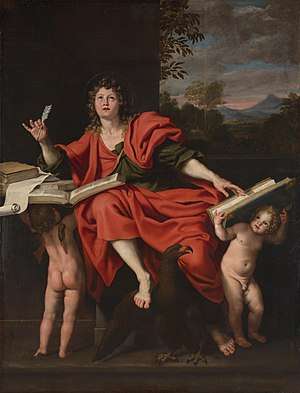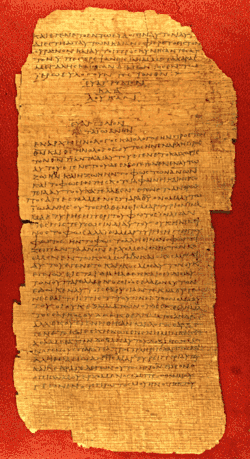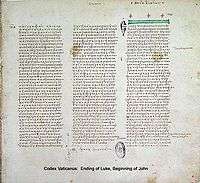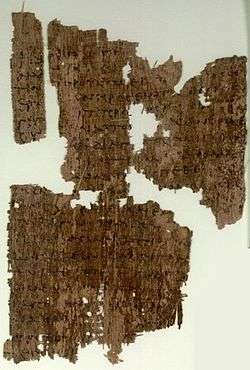John 1
| John 1 | |
|---|---|
|
← Luke 24 | |
 John 1:21–28 on Papyrus 119, written about AD 250. | |
| Book | Gospel of John |
| Bible part | New Testament |
| Order in the Bible part | 4 |
| Category | Gospel |
| Part of a series of articles on |
| John in the Bible |
|---|
 |
| Johannine literature |
| Authorship |
| Related literature |
| See also |
John 1 is the first chapter in the Gospel of John in the New Testament of the Christian Bible. The book containing this chapter is anonymous, but early Christian tradition uniformly affirmed that John composed this gospel.[1]
Text
- The original text is written in Koine Greek.
- Some most ancient manuscripts containing this chapter are:
- Papyrus 75 (written c. 175 – c. 225 AD)
- Papyrus 66 (200 AD; complete)
- Papyrus 5 (c. 250)
- Papyrus 119 (c. 250; extant: verses 21–28, 38–44)
- Papyrus 106 (3rd century)
- Codex Vaticanus (c. 325 – c. 350)
- Codex Sinaiticus (c. 350; complete)
- Papyrus 120 (4th century; extant: verses 25–28,38–44)
- Codex Bezae (c. 400)
- Codex Washingtonianus (c. 400)
- Codex Alexandrinus (c. 400 – c. 440; almost complete)
- Codex Ephraemi Rescriptus (c. 450; extant: verses 4–40)
- Codex Borgianus (5th century; extant: verses 24–32 in Greek; 16–23 in Sahidic Coptic)
- Papyrus 55 (6th to 7th century; extant: verses 31–33, 35–38).
- Papyrus 59 (7th century; extant: verses 26, 28, 48, 51).
 Papyrus 75, page containing the end of Gospel of Luke (chapter 24:51–53) followed by the beginning of Gospel of John (chapter 1:1–16*)
Papyrus 75, page containing the end of Gospel of Luke (chapter 24:51–53) followed by the beginning of Gospel of John (chapter 1:1–16*) Papyrus 120, John 1:25–28
Papyrus 120, John 1:25–28- Codex Bezae, John 1:1–16
- Codex Alexandrinus, John 1:1–7.
Analysis
The first chapter of the Gospel of John has 51 verses and can be divided in three parts:
Hymn to the Word (verses 1–18)
The first part (verses 1–18), often called the Hymn to the Word, is a prologue to the gospel as a whole, stating that the Logos is "God" ("divine", "god-like", or "a god"[2] according to some translations).
Comparisons can be made between these verses and the narrative of Genesis 1, where the same phrase In the beginning first occurs along with the emphasis on the difference between the darkness (such as the earth was formless and void, Genesis 1:2) and the light (the ability to see things not understood/hidden by the darkness, John 1:5).
John Wesley summarised the opening verses of John 1 as follows:
- John 1:1–2 describes the state of things before the creation
- John 1:3 describes the state of things in the creation
- John 1:4 describes the state of things in the time of man's innocence
- John 1:5 describes the state of things in the time of man's corruption.[3]
According to the writers of the Pulpit Commentary, the phrase "the light of men" (John 1:4) "has been differently conceived by expositors. John Calvin supposed that the "understanding" was intended—"that the life of men was not of an ordinary description, but was united to the light of understanding," and is that by which man is differentiated from animals. Hengstenberg regards it, in consequence of numerous associations of "light" with "salvation" in Holy Scripture, as equivalent to salvation; Christoph Ernst Luthardt with "holiness" and many with the "eternal life", which would introduce great tautology."[4]
English translations of John 1:5 variously translate the Greek κατελαβεν as "understanding" (e.g. the New King James Version: "the light shines in the darkness, and the darkness did not comprehend it"), but in other translations the meaning is given in terms of a struggle between darkness and light: "the light shines in the darkness, and the darkness has not overcome it" (Revised Standard Version). Verses 10 and 11 state that "He was in the world, and the world was made through Him, and the world did not know Him. He came to His own, and His own did not receive Him" [5] but theologians differ in their interpretation of these verses. Wesley viewed "in the world" as meaning "even from the creation",[3] the Pulpit Commentary speaks of the "pre-Incarnation activity" of the Word [4] and Joseph Benson wrote that "He was in the world ... from the beginning, frequently appearing, and making known to his servants, the patriarchs and prophets, the divine will, in dreams and visions, and various other ways",[6] whereas in Albert Barnes' opinion, "He was in the world [...] refers, probably, not to his pre-existence, but to the fact that he became incarnate; that he dwelt among human beings".[7]
The summation of the comparison between darkness and light occurs in the statement "the law was given through Moses [...] grace and truth came through Jesus Christ" (John 1:17). Here John successfully bridges the gap for the reader—including Jewish readers well-versed in the Torah—from the Law to the One who would fulfill the Law (such as the requirement of animal sacrifice for the forgiveness of sins, Hebrews 9:22), Jesus.
Testimony of John the Baptist (verses 19–34)


The second part (verses 19–34) shows the preparation that John the Baptist was in the process of making for the coming of the Messiah, the Messiah's arrival and the Messiah's first disciples. John has been introduced in verse 6 ("a man sent from God") [8] and his witness, known already by the reader, has already been recalled: "This is the One I told you about".[9] The Greek text has the past tense (εἶπον) but both Charles Ellicott and the Cambridge Bible for Schools and Colleges prefer a present tense translation such as "John bears witness".[10] Verses 19–34 present John's manifesto, delivered to the priests and Levites sent by the Pharisees to investigate his message and purpose. In response to their enquiries, John confesses that he is not the Messiah, nor the reappearance of the prophet Elijah (contrast Matthew 11:14, where Jesus states that John is "Elijah who is to come"), nor "the prophet".[11]
John then reveals that when the One comes he would be unfit to even so much as untie his sandals—let alone baptize Him like the many he had up to that point. No sooner than the next day the Messiah appears before John the Baptist and he then acknowledges Jesus as the Lamb of God of whom he had been speaking (verse 30).
The evangelist divides this series of events into four 'days': the day (or period) when the Jerusalem delegation met John to enquire into his identity and purpose (verses 19–29) is followed by John seeing Jesus coming towards him "the next day" (verse 29), and on "the next day again" [12] he directs his own disciples towards following Jesus (verses 35–37). A fourth 'day' follows (verse 43) on which Jesus wanted to go to Galilee and invited Philip to follow him. Bengel calls these "Great Days!"[13]
Jesus' first disciples (verses 35–51)
As the chapter progresses further, the gospel describes how Jesus calls his first disciples, Andrew and an unnamed disciple (verses 35–40). The unnamed disciple was possibly John, the evangelist.[4] Andrew finds his brother Simon (verses 41–42), and Jesus changes Simon's name to Cephas (Peter) (verse 42). Cephas, original Greek: Κηφᾶς (Kēphâs), means "a rock" (Young's Literal Translation) or "a stone" (King James Version). This provided a powerful analogy as to the role Peter would have after the crucifixion; to lead the development of the church. Name changes occur other places in the Bible and demonstrate God's authority as well as what that person would become, do, or had done, such as Abram to Abraham and Jacob to Israel. Jesus' first active sign of power was to Nathaniel, who was thoroughly impressed by Jesus' foreknowledge of his personal character.
Within these verses Jesus is given the following titles:
- the Lamb of God (verses 29, 35)
- the Son of God (verses 34, 49)
- Rabbi, meaning Teacher or Master (verses 38, 49)
- the Messiah, or the Christ (verse 41)
- the one of whom Moses wrote in the law (verse 45, referring to Deuteronomy 18:15: "The Lord your God will raise up for you a Prophet like me from your midst, from your brethren: him you shall hear")
- Jesus of Nazareth, son of Joseph (verse 45)
- the King of Israel (verse 49)
- the Son of Man (verse 51).
Chronology
Verses 1:19 to 2:1 contains a chronological record of an eyewitness:[14]
- Day 1: the Jews sent priests and Levites from Jerusalem to ask John the Baptist (John 1:19–1:28).
- Day 2 ("the next day"): John saw Jesus coming toward him, and said, "Behold! The Lamb of God who takes away the sin of the world!..."(John 1:29–1:34).
- Day 3 ("again, the next day"): John stood with two of his disciples, and looking at Jesus as He walked, he said, "Behold the Lamb of God!": The two disciples heard him speak, and they followed Jesus. One of them is mentioned by name as "Andrew, Simon Peter's brother"; the other one not named is the eyewitness, who is John the evangelist (John 1:35–1:40).
- Day 4 (one day after Andrew and John stayed with Jesus for the rest of Day 3): Andrew brought Simon Peter to Jesus (John 1:41–1:42).
- Day 5 ("the following day"; Day 1 of travel to Cana): Philip and Nathanael followed Jesus (John 1:43–1:51).
- Day 6 (Day 2 on the way to Cana): Travel to Galilee (John 1:43).
- Day 7 ("on the third day"): The wedding in Cana of Galilee (John 2:1).
Liturgical use
In the Latin Rite of the Catholic Church and in Western Rite Orthodoxy, the chapter's first fourteen verses are known as the "Last Gospel", as they are recited at the end of the Tridentine Mass (or "Extraordinary Form") of the Mass. This is distinct from the Proclamation of the Gospel that occurs much earlier in the service.
After reciting the dismissal formula Ite Missa est, the priest reads the Last Gospel in Latin from the altar card to their left. At the beginning of verse 14, Et Verbum caro factum est ("And the Word became flesh"), they genuflect. Any congregants present, who remain standing for the reading, would kneel at this point, responding with Deo gratias ("Thanks be to God") at its conclusion.
This ritual began as a private devotion for the priest after Mass. It is not part of the 1969 Mass of Paul VI (known as the "Ordinary Form" widely used today) that was introduced after the Second Vatican Council.
References
- ↑ Holman Illustrated Bible Handbook. Holman Bible Publishers, Nashville, Tennessee. 2012.
- ↑ Duff, Jeremy, The Elements of New Testament Greek (3rd ed.), Cambridge University Press, 2005. ISBN 0-521-75550-6. "[W]e can't tell if the author meant the word was θεός [a god] or ό θεός [God]," says in p. 63, ft. 3.
- 1 2 Wesley, J., Notes on the Gospel according to Saint John on John 1:3, accessed 24 January 2015
- 1 2 3 Pulpit Commentary on John 1, accessed 25 January 2016
- ↑ John 1:10–1:11
- ↑ Benson Commentary on John 1, accessed 27 January 2016
- ↑ Barnes' Notes on the Bible on John 1, accessed 27 January 2016
- ↑ Sent "by" God in the New Century Version and some other translations
- ↑ John 1:15
- ↑ Ellicott's Commentary for English Readers on John 1, and Cambridge Bible for Schools and Colleges on John 1, accessed 28 January 2016
- ↑ John 1:19–1:21
- ↑ Cambridge Bible for Schools and Colleges on John 1, accessed 31 January 2016
- ↑ Bengel's Gnomon of the New Testament on John 1, accessed 31 January 2016
- ↑ Exegetical Commentary on John 1 (verses 1:19–51), Study By: W. Hall Harris III
External links


| Preceded by Luke 24 |
Chapters of the Bible Gospel of John |
Succeeded by John 2 |